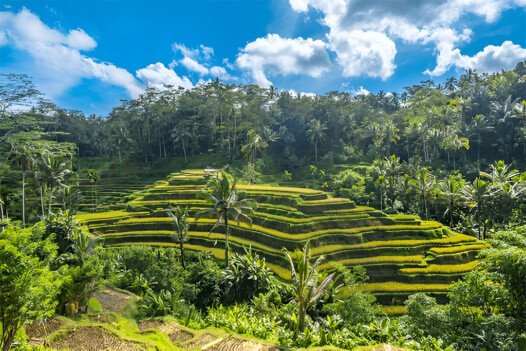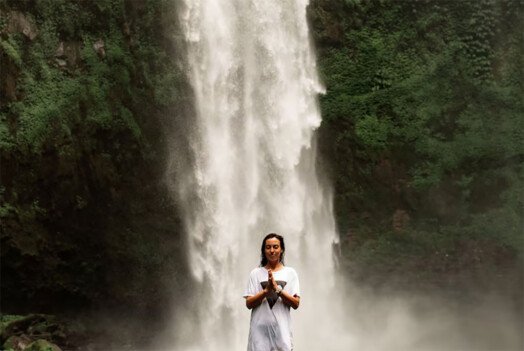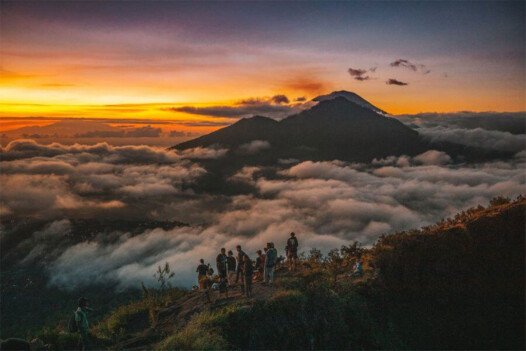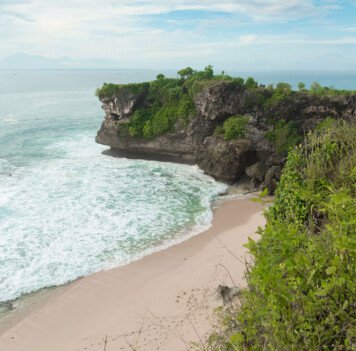Bali is renowned for its lush landscapes, vibrant culture, and spiritual heritage. At the heart of this island lies its sacred mountains—majestic peaks that not only define Bali’s topography but also its spiritual landscape. These mountains are more than just natural wonders; they are revered as abodes of deities, sites of pilgrimage, and symbols of the island’s deep-rooted Hindu traditions.
🗻 Mount Agung: Bali’s Spiritual Pinnacle
🌋 The Sacred Volcano
Mount Agung, standing at 3,031 meters, is Bali’s highest and most active volcano. Located in Karangasem Regency, it dominates the eastern skyline and is considered the holiest mountain by the Balinese. According to local legend, Mount Agung was once part of Mount Semeru in Java, transported to Bali by a giant tortoise and three holy dragons .
⛩️ Pura Besakih: The Mother Temple
Perched on the slopes of Mount Agung is Pura Besakih, Bali’s largest and holiest temple complex. Comprising 23 temples, it serves as the spiritual heart of the island. The temple’s main sanctuary, Pura Penataran Agung, is aligned with the mountain’s peak, symbolizing the connection between the divine and the earthly realms.
🥾 Hiking Mount Agung
Trekking Mount Agung is a challenging endeavor, typically requiring a guide due to the steep terrain and unpredictable weather conditions. The hike begins around midnight to reach the summit by sunrise, offering panoramic views of the island and, on clear days, the neighboring island of Lombok.
🌋 Mount Batur: The Sunrise Trek
🌄 A Popular Sunrise Destination
Mount Batur, an active volcano in Kintamani, stands at 1,717 meters. It’s renowned for its sunrise treks, attracting both seasoned hikers and beginners. The journey to the summit takes approximately three hours, passing through volcanic terrain and offering breathtaking views of the surrounding landscape.
🛕 Pura Luhur Batukaru: A Serene Retreat
Located on the southern slopes of Mount Batukaru, Bali’s second-highest volcano, Pura Luhur Batukaru is one of the island’s nine directional temples. Dedicated to the god Mahadewa, the temple is a serene place of worship, surrounded by dense rainforest. Its isolation provides a peaceful retreat for those seeking spiritual solace.
🏞️ Mount Lempuyang: The Stairway to Heaven
🏯 Pura Lempuyang Luhur
Mount Lempuyang, also known as Lempuyang Luhur, is home to one of Bali’s most iconic temples. The Pura Lempuyang Luhur complex consists of seven temples along the ascent to the summit. The most famous is Pura Penataran Agung Lempuyang, known for its split gate framing Mount Agung in the background—a popular photo spot for visitors.
🧗♂️ The Ascent
The hike to Pura Lempuyang Luhur is a spiritual journey, with each temple representing a step toward purification. The trail is steep, with over 1,700 steps leading to the summit. The effort is rewarded with panoramic views and a profound sense of accomplishment.
🧘♀️ Spiritual Significance and Cultural Practices
🕉️ Hindu Cosmology and the Mountains
In Balinese Hinduism, the mountains are considered sacred manifestations of Mount Meru, the center of the universe. Each mountain has its own deity and is associated with specific rituals and ceremonies. Pilgrimages to these mountains are seen as acts of devotion and purification.
🛕 Temple Festivals
Each sacred mountain hosts annual temple festivals, known as “odalan,” which are significant events in the Balinese calendar. These festivals involve elaborate ceremonies, offerings, and traditional dances, drawing devotees from across the island.
🌿 Flora and Fauna of Bali’s Mountains
🌱 Biodiversity Hotspots
Bali’s mountains are rich in biodiversity, home to unique species of flora and fauna. The volcanic soils support dense forests, while the cooler temperatures at higher elevations provide habitats for various wildlife. Species such as the Bali starling and various endemic orchids can be found in these regions.
🌾 Agricultural Practices
The fertile volcanic soils of Bali’s mountains support traditional agricultural practices. Terraced rice fields are a common sight, particularly in areas like Jatiluwih, a UNESCO World Heritage site. These terraces not only contribute to the island’s economy but also enhance its scenic beauty.
🧭 Practical Tips for Visiting Bali’s Sacred Mountains
🧳 What to Bring
- Comfortable Hiking Shoes: The trails can be steep and rocky.
- Warm Clothing: Temperatures can drop significantly at higher elevations.
- Flashlight or Headlamp: Essential for early morning treks.
- Water and Snacks: Stay hydrated and energized.
- Rain Gear: Weather can change abruptly.
🚶♂️ Hiring a Guide
While some trails may be accessible without a guide, it’s recommended to hire a local guide for safety and to enrich your experience with cultural insights. Guides are familiar with the terrain and can provide valuable information about the mountain’s spiritual significance.
🕰️ Best Time to Visit
The dry season, from May to September, is ideal for hiking. During this period, the weather is more predictable, and trails are less slippery. However, be prepared for crowds, especially during peak tourist months.
📸 Capturing the Essence of Bali’s Sacred Mountains
The sacred mountains of Bali offer numerous opportunities for photography. From the sunrise over Mount Batur to the intricate carvings at Pura Lempuyang, each moment is a testament to the island’s natural and spiritual beauty. Remember to be respectful of local customs and seek permission before photographing religious ceremonies.
🧘♂️ Embracing the Spiritual Journey
Visiting Bali’s sacred mountains is more than just a physical journey; it’s a spiritual odyssey. The mountains offer a chance to connect with nature, reflect on one’s inner self, and experience the profound spirituality that permeates the island. Whether you’re seeking adventure, tranquility, or enlightenment, Bali’s sacred mountains provide a path to all.









